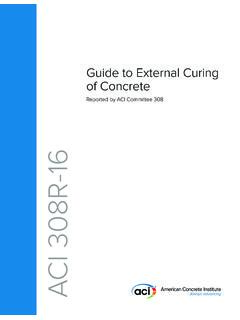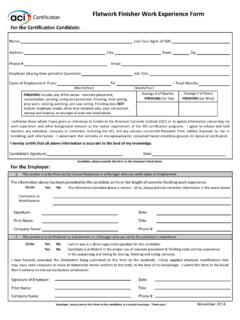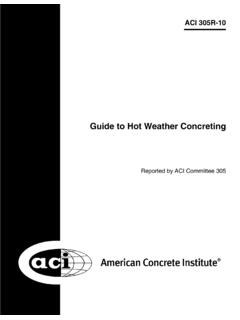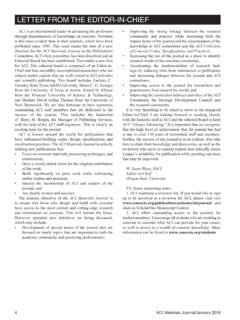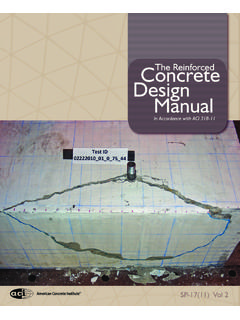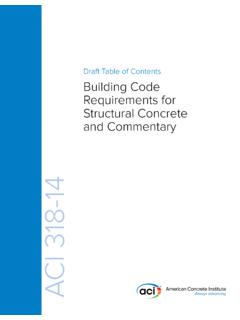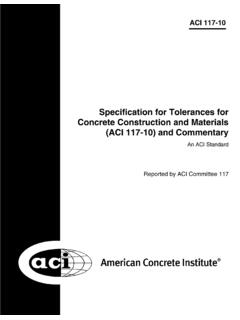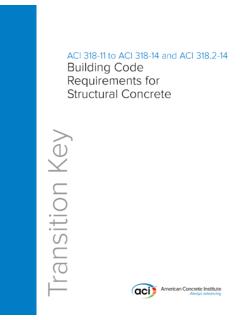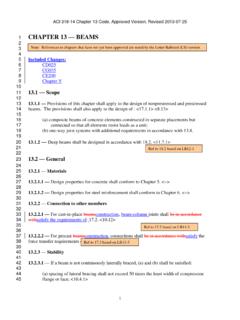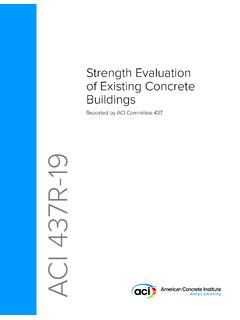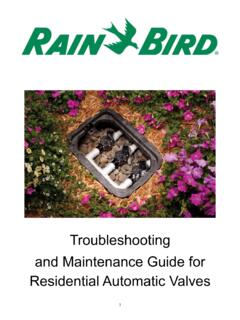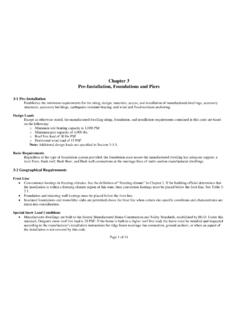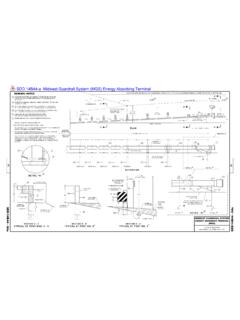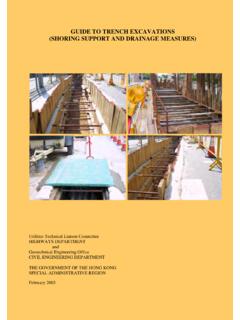Transcription of Reported by Committee 302 - American Concrete Institute
1 The attached excerpted resource materials have been made available for use within ACI obtain a full version of this document, please visit the ACI additional education products, please visit ACI quality of a Concrete floor or slab is highly dependent on achieving a hard and durable surface that is flat, relatively free of cracks, and at the proper grade and elevation. Properties of the surface are determined by the mixture proportions and the quality of the concreting and jointing operations. The timing of concreting operations especially finishing, jointing, and curing is critical. Failure to address this issue can contribute to undesirable char-acteristics in the wearing surface such as cracking, low resistance to wear, dusting, scaling, high or low spots, poor drainage, and increasing the potential for floor slabs employing portland cement, regardless of slump, will start to experience a reduction in volume as soon as they are placed.
2 This phenomenon will continue as long as any water, heat, or both, is being released to the surroundings. More-over, because the drying and cooling rates at the top and bottom of the slab are not the same, the shrinkage will vary throughout the depth, causing the as-cast shape to be distorted and reduced in guide contains recommendations for controlling random cracking and edge curling caused by the Concrete s normal volume change. Application of present technology permits only a reduc-tion in cracking and curling, not elimination. Even with the best floor designs and proper construction, it is unrealistic to expect completely crack- and curl-free floors. Consequently, every owner should be advised by both the designer and contractor that it is completely normal to expect some amount of cracking and curling on every project, and that such an occurrence does not necessarily reflect adversely on either the adequacy of the floor s design or the quality of its construction (Ytterberg 1987).
3 This guide describes how to produce high-quality Concrete slabs-on- ground and suspended floors for various classes of service. It emphasizes such aspects of construction as site preparation, Concrete materials, Concrete mixture proportions, Concrete work-manship, joint construction, load transfer across joints, form strip-ping procedures, finishing methods, and curing. Flatness/levelness requirements and measurements are outlined. A thorough precon-struction meeting is critical to facilitate communication among key participants and to clearly establish expectations and procedures that will be employed during construction to achieve the floor qual-ities required by the project specifications. Adequate supervision and inspection are required for job operations, particularly those of : admixture; aggregate; consolidation; contract documents; curing; curling; deflection; durability; form; fracture; joint; mixture propor-tioning; placing; quality control; slab-on- ground ; slabs; slump 1 INTRODUCTION, p.
4 Purpose, p. Scope, p. 2 CHAPTER 2 DEFINITIONS, p. 2 CHAPTER 5 DESIGN CONSIDERATIONS, p. Scope, p. Slabs-on- ground , p. Suspended slabs, p. Miscellaneous details, p. 9 Joseph F. Neuber Jr., ChairPatrick J. Harrison, Vice ChairRussell E. Neudeck, SecretaryACI to Concrete Floor and Slab ConstructionReported by Committee 302 Dennis C. AhalBryan M. BirdwellPeter A. CraigAllen FaceC. Rick FelderEdward B. FinkelBarry E. ForemanGreg K. FricksTerry J. FricksJerry A. HollandPhilip S. KopfSteve R. Lloyd, A. MacDonaldArthur W. McKinneyDonald M. McPheeScott C. MetzgerJeffrey S. MillerScott L. NiemitaloNigel K. ParkesWilliam S. PhelanTim H. RobinsonJohn W. RohrerPaul A. Rouis, IIID omenick Thomas RutturaBruce A. SuprenantScott M. TarrConsulting MembersCarl Bimel*Michael A. ClarkWilliam C. PanareseBrian J. PashinaBoyd C.
5 Ringo**DeceasedACI Committee Reports, Guides, and Commentaries are intended for guidance in planning, designing, executing, and inspecting construction. This document is intended for the use of individuals who are competent to evaluate the significance and limitations of its content and recommendations and who will accept responsibility for the application of the informa-tion it contains. ACI disclaims any and all responsibility for the stated principles. The Institute shall not be liable for any loss or damage arising there to this document shall not be made in contract documents. If items found in this document are desired by the Architect/ Engineer to be a part of the contract documents, they shall be restated in mandatory language for incorporation by the supersedes ACI and was adopted and published June 2015, American Concrete rights reserved including rights of reproduction and use in any form or by any means, including the making of copies by any photo process, or by electronic or mechanical device, printed, written, or oral, or recording for sound or visual reproduc-tion or for use in any knowledge or retrieval system or device, unless permission in writing is obtained from the copyright 1 PurposeThis guide presents information relative to the construction of slab-on- ground and suspended-slab floors for industrial, commercial.
6 And institutional buildings. It is applicable to the construction of normalweight and structural lightweight Concrete floors and slabs made with conventional portland and blended cements. This guide identifies the various classes of floors based on use, construction design details, necessary site preparation, Concrete type, and other related materials. In general, characteristics of the Concrete slab surface and joint performance have a powerful impact on the serviceability of floors and other slabs. Because the eventual success of a Concrete floor installation depends on the mixture proportions and floor finishing techniques used, considerable attention is given to critical aspects of achieving the desired finishes and the required floor surface ScopeThis guide emphasizes choosing and proportioning of materials, design details, proper construction methods, and workmanship.
7 Slabs specifically intended for the containment of liquids are beyond the scope of this guide. Whereas this guide does provide a reasonable overview of Concrete floor construction, each project is unique and circumstances can dictate departures from the recommendations given in this guide. Contractors and suppliers should, therefore, thoroughly review contract documents before bid preparation (Chapter 3).CHAPTER 2 DEFINITIONSACI provides a comprehensive list of definitions through an online resource, ACI Concrete Terminology, Definitions provided herein complement that set time difference in timing from initial introduction of water to Concrete mixture at batch plant to initial power dry mixture of hydraulic cement and fine aggregate (either mineral or metallic) that is distributed evenly over the surface of Concrete flatwork and worked into the surface before time of final setting and then floated and troweled to desired optimization indicator intersection of the coarseness factor value and the workability factor on the coarseness factor creation of troughs in the soil support system in response to applied wheel creation of lines or notches in the surface of a Concrete pumping vertical displacement and rebound of the soil support system in response to applied moving slump magnitude of slump, measured in accor-dance with ASTM C143/C143M, which is directly attributed to the amount of water in the Concrete of finishability time period available for finishing operations after the Concrete has been placed, consolidated.
8 And struck-off, and before final factor percentage of combined aggregate that passes the No. 8 ( mm) 5 DESIGN ScopeChapter 5 addresses the design of Concrete floors as it relates to their constructibility. Specific design requirements for Concrete floor construction are found in ACI 360R for slabs-on- ground , ACI 223R for shrinkage-compensating Concrete floors, and ACI and for suspended Required design elements Following are the minimum items that should be addressed in the construction documents prepared by the designer (ACI 360R):a) Slab-on- ground design criteriab) Base and subbase materials, preparation requirements, and vapor retarder/barrier, when requiredc) Concrete thicknessd) Concrete compressive strength, flexural strength, or bothe) Concrete mixture proportion requirements, ultimate drying shrinkage strain, or bothf) Joint locations and detailsg) Reinforcement (type, size, and location) when requiredh) Surface treatment, when requiredi) Surface finishj) Tolerances (base, subbase, slab thickness, and floor flat-ness and levelness)k) Concrete curingl) Joint filling material and installationm) Special embedmentsn) Testing requirementso)
9 Preconstruction meeting, quality assurance, and quality controlIf any of this information is not provided, the contractor should request it from the slab-on- ground slab Soil-support system Because the performance of a slab-on- ground depends on the integrity of the soil-support system, specific attention should be given to site preparation requirements, including proof-rolling ( ). In most cases, proof-rolling results are much more indicative of the soil-support system s ability to withstand loading than from the results of in-place tests of moisture content or density. A thin layer of graded, granular, compactible material is normally used as fine grading material to better control Concrete s thick-ness and to minimize friction between the base material and slab. For detailed information on soil-support systems, refer to ACI Moisture protection Proper moisture protection is essential for any slab-on- ground where the floor will be covered by moisture-sensitive flooring materials such as vinyl; linoleum; wood; carpet; rubber; rubber-backed carpet tile; impermeable floor coatings; adhesives; or where moisture-sensitive equipment, products, or environments exist, such as humidity-controlled or refrigerated rooms.
10 American Concrete Institute Copyrighted Material GUIDE TO Concrete FLOOR AND SLAB CONSTRUCTION (ACI )ACI provides recommendations for the design and construction of Concrete slabs that will receive moisture-sensitive or pH-sensitive flooring materials or coatings for both slabs-on- ground and suspended Vapor retarder permeance A vapor retarder/barrier is a material that is intended to minimize the trans-mission of water vapor upward through the slab from sources below. The performance requirements for plastic vapor retarder/barrier materials in contact with soil or granular fill under Concrete slabs are listed in ASTM E1745. According to ASTM E1745 a vapor retarder/barrier material is to have a permeance level, also known as the water vapor transmission rate, not exceeding perms as determined by ASTM E96/E96M or ASTM F1249.
